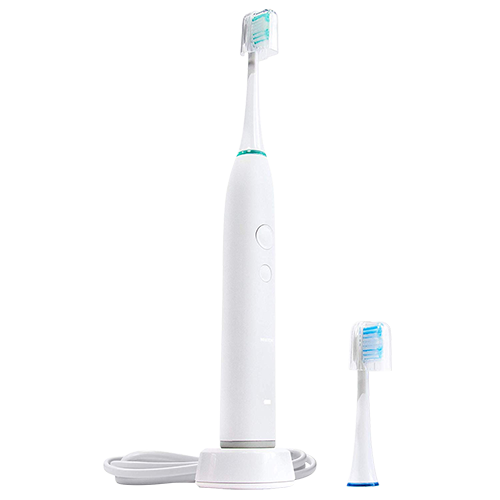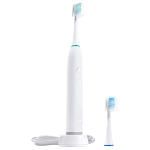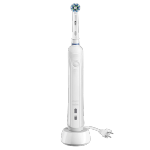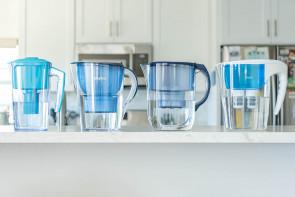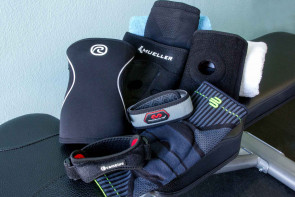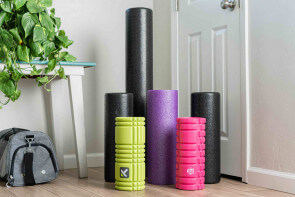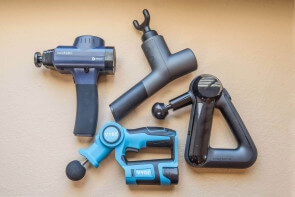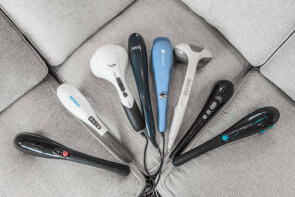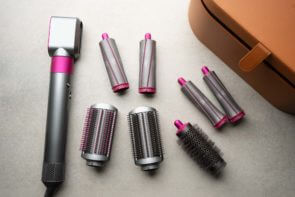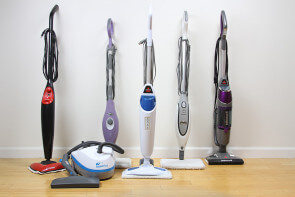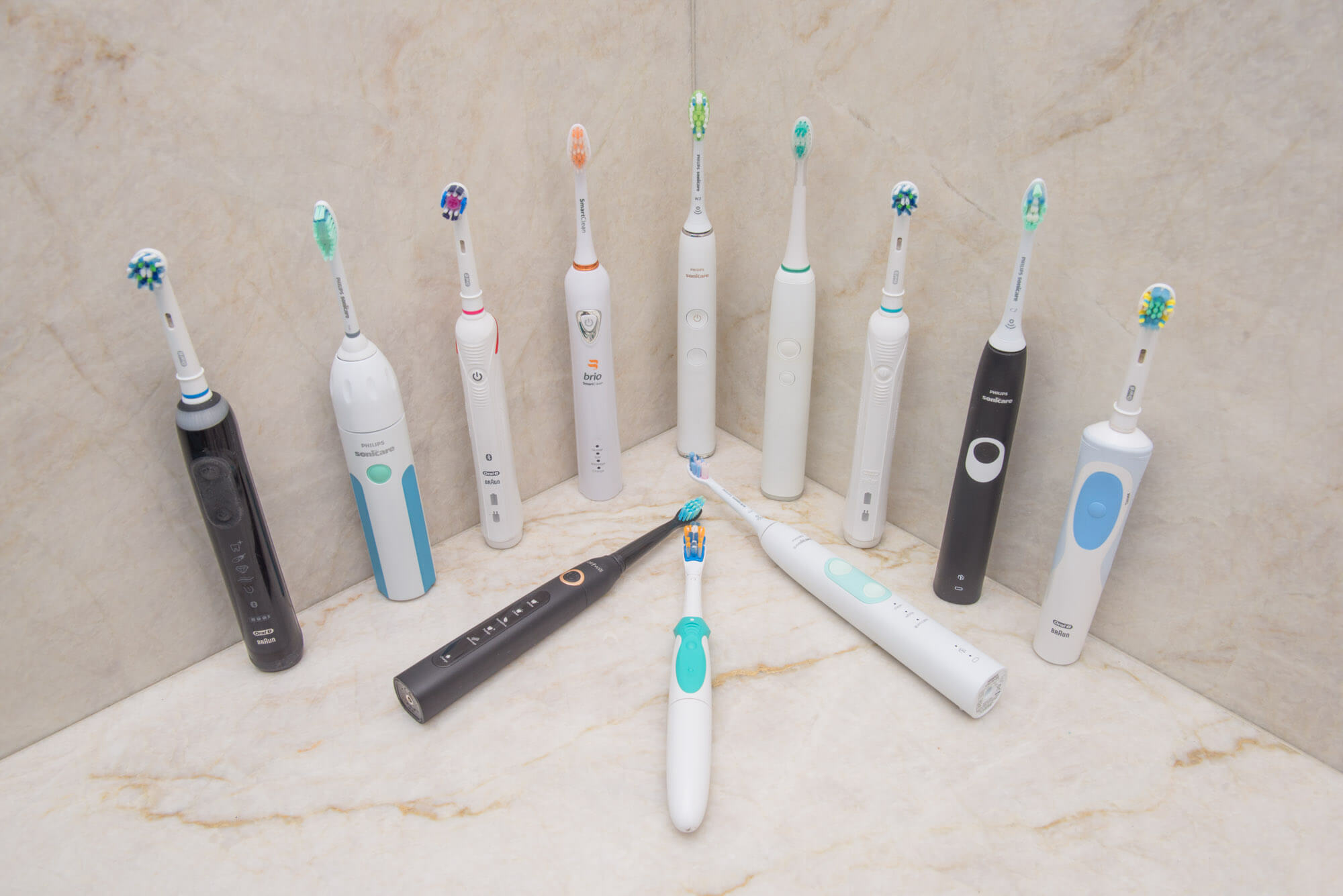
The Best Electric Toothbrushes
We asked a family to test and rank the performance of twelve highly-rated electric toothbrushes. After four months of daily brushing, plus controlled lab tests for power and battery life, we picked the sonic-action Greater Goods – Balance as the best electric toothbrush. This value-priced model features soft bristles, top-tier performance and the best timer functions. If you’re ticklish, the Oral-B – Pro 1000 is a great brush that doesn’t use sonic vibration.
We asked a family to test and rank the performance of twelve highly-rated electric toothbrushes. After four months of daily brushing, plus controlled lab tests for power and battery life, we picked the sonic-action Greater Goods – Balance as the best electric toothbrush. This value-priced model features soft bristles, top-tier performance and the best timer functions. If you’re ticklish, the Oral-B – Pro 1000 is a great brush that doesn’t use sonic vibration.
Table of contents
- How we selected products to test
- Compare the best electric toothbrushes
- Sonic vs. oscillating toothbrushes
- Important features to consider
- How we tested
- Finding the best electric toothbrush for kids
- Top pick: Greater Goods – Balance
- For sensitive teeth: Oral-B – Pro 1000
- Best premium electric: Philips – DiamondClean
- The other finalists we tested
- The bottom line
How we selected products to test
If you’ve been going to regular dental checkups in the last decade or so, you’ve probably been told to buy an electric toothbrush. When our researcher asked his dentist which brand was recommended after a checkup a few years ago, he said very simply that they’re all pretty good.
/r/Dentistry provides some great discussion about the need for good technique even with a superior toothbrush. It’s clear that people tend to favor one of the two most popular brands — Oral-B and Philips — but that preference isn’t based on one obvious preference or another.
After reading reviews from sites like Wirecutter, Techgearlab, and Dentaldorks, it became apparent to us that the differences between brushes would be tricky to test. Consumer Reports, one of the most trusted institutions in unbiased product comparisons, has completely given up testing and recommending specific brushes.
The leading brands are easy to spot; they have TV commercials and YouTube celebrities promoting them. We were curious about up-and-coming contenders, though. There are dozens of other companies making brushes, but are any of them good? Our final list includes three best-selling underdog models that offer features that compete with the big brands.
After noting that heads on kid-specific models were mostly identical to the “sensitive” replacement heads made for the “big” adult handles, we decided to test brush systems that would work for a whole family rather than testing an entire “for-kids” category separately.
After eliminating obsolete models and closely scrutinizing reviews of the 23 most popular models, we narrowed that list to a set of 12 contenders that we hoped would provide a diverse range of test results.
We included an under-$10 AA-battery-powered brush mostly to calibrate our expectations for midrange brushes, and decided to spring for a pair of ultra-premium brushes just to see what that kind of money can get you.
We decided not to test subscription services this time around, mostly because the new kids on the block seem very similar to the big brands without actually competing on price. (Goby, for example, is more expensive than Oral-B, with fewer features.)
Compare the best electric toothbrushes
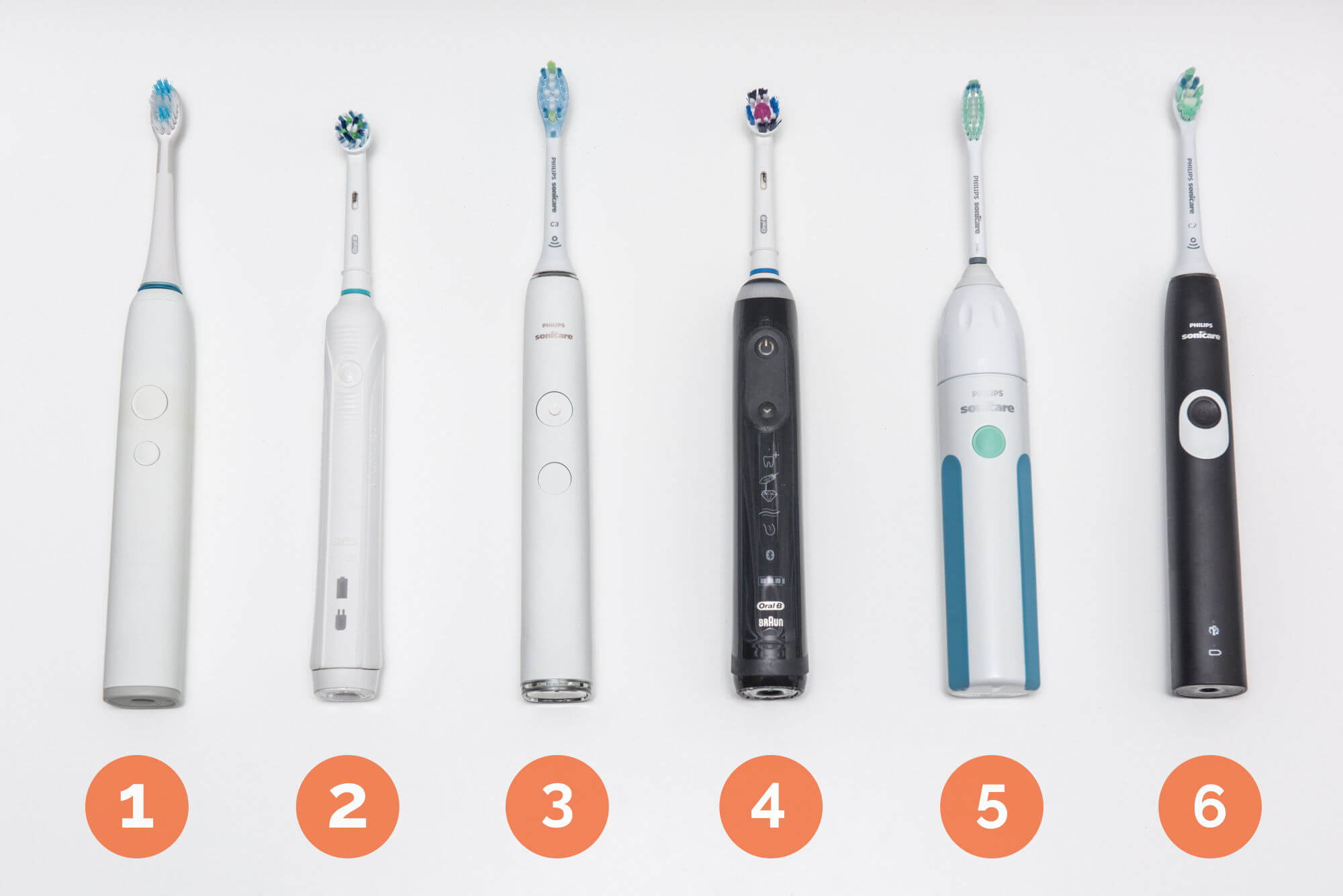
| Electric Toothbrush | Price | Tested Battery Life (Minutes) | Cost of Heads | Cleaning Test (Score out of 6) | Quad Pace Timer? |
|---|---|---|---|---|---|
| 1. Greater Goods - Balance | $ | 98 | $ | 6 | Yes |
| 2. Oral-B - Pro 1000 | $$ | 44 | $ | 2 | Yes |
| 3. Philips - DiamondClean | $$$$$ | 114 | $$$$ | 6 | Yes |
| 4. Oral-B - Genius 8000 | $$$$$ | 64 | $ | 4 | Yes |
| 5. Philips - Sonicare Essence | $ | 152 | $$$ | 5 | No |
| 6. Philips - Sonicare 4100 | $$ | 180 | $$$ | 5 | Yes |
| 7. Philips - Sonicare 5100 | $$$ | 154 | $$$ | 5 | Yes |
| 8. Oral-B - Pro 3000 | $$$$ | 42 | $ | 2 | Yes |
| 9. Brio - SmartClean | $$$ | 284 | $$ | 4 | Yes |
| 10. Fairywill - FW-507 | $$ | 288 | $ | 4 | Yes |
| 11. Oral-B - Vitality | $ | 70 | $ | 3 | No |
| 12. Oral-B - 3D White | $ | 305 | $ | 4 | No |
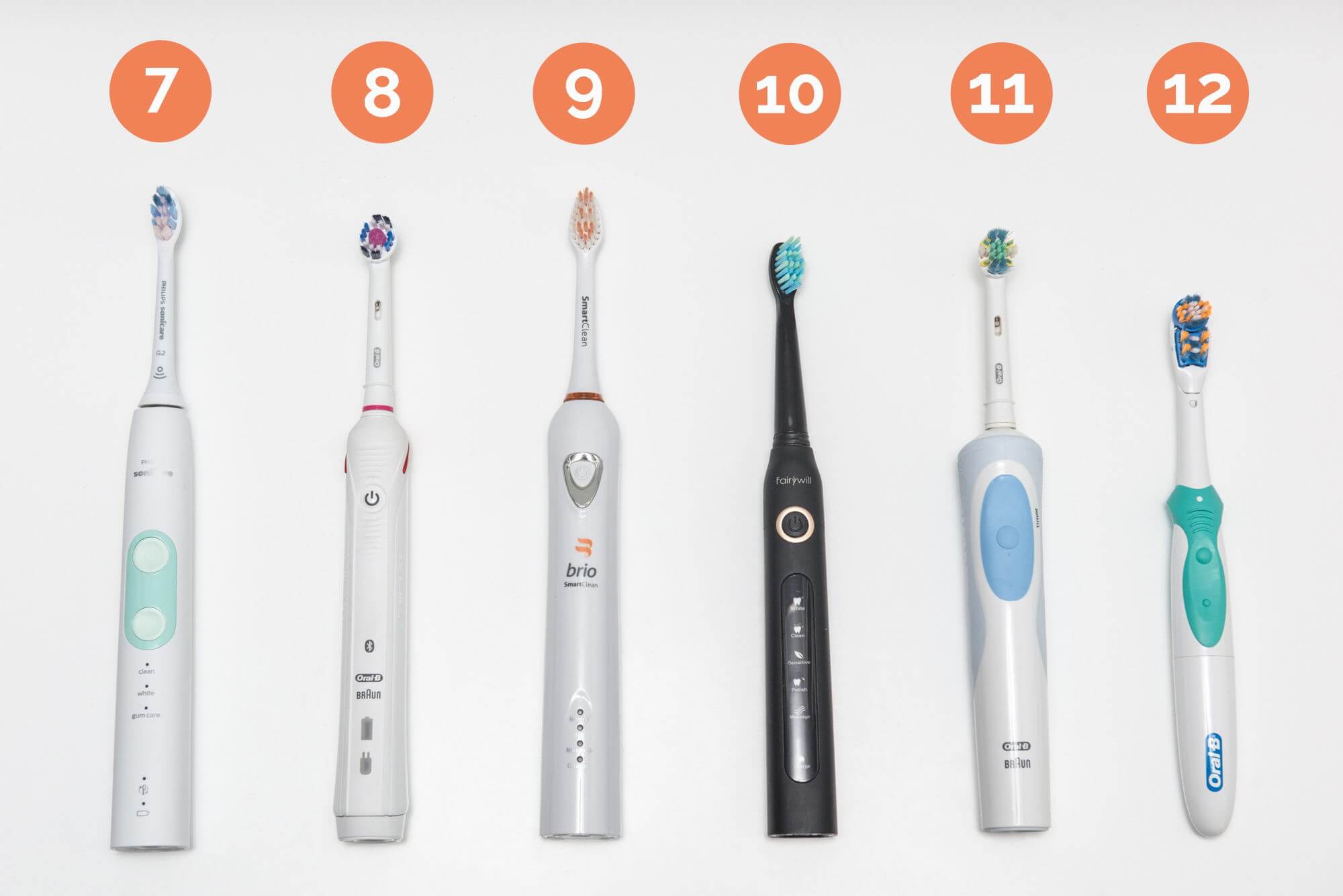
Sonic vs. oscillating toothbrushes
There are plenty of ways you could make a toothbrush work, from direct-drive gears to ionic plaque removal, but there are two popular types that are easy to find and proven to work:
Sonic toothbrushes use a motor to move bristles very quickly with pulses of vibration, somewhere from 250 to 350 pulses per second. (The Sonicare Essence is a middle C at 261 Hz if you check it with a tuner.) A pulse is usually counted as both a back-and-forth stroke, so around 516 strokes per second (“31,000 brush strokes per minute”) is a common advertising claim. The vibrations definitely move the bristles, but less than a sixty-
fourth of an inch to either side.
Oscillating toothbrushes are almost exclusively made by Oral-B. Rather than vibrating like the sonic types, or spinning the brush head in one direction like a polishing tool, these heads spin in a back-and-forth motion that mimics very quick manual brushing. The brush head rotates back and forth about 125 times per second, with about a quarter-inch of brush movement each cycle.
So, which is better? Cochrane Oral Health reported in 2010 that out of 17 trials with 1369 participants, they found no evidence that one type of brush was better than the other.
One 2007 study found that the smaller Oral-B heads had an advantage over the larger heads used by Philips, while according to this review in the journal of periodontology and another review by Cochrane, some of the slight edge that Oral-B has in broad reviews of studies is probably because oscillating heads are tested more often.
Philips claims that their Sonicare system can dislodge and clear gunk (and even plaque) in places that a moving toothbrush bristle can’t. By all indications, it’s a system that works: The studies they’ve chosen to publish on their own site try to show that when you tally all the oscillating-vs-manual and sonicare-vs-manual results, Sonicare is slightly better at removing plaque and keeping gingivitis at bay.
The biggest differences, then, are going to be very personal. Some find the loud, rattling head on the Oral-B brushes to be annoying, while people with ticklish mouths may find the vibration of the sonic brushes unbearable.
Important features to consider
Two-minute timer: This is the most important feature of an electric toothbrush, arguably even more important than the motorized bristles. A two-minute timer will encourage most people to brush for the right amount of time, and if it’s built into the toothbrush you won’t forget it the way you might with an app or countertop timer.
Quad pacer: This is an additional feature of better toothbrush timers: Rather than simply notifying you of when two minutes is up, a pacer tells you when you’ve spent 30 seconds on one quadrant of your mouth. When you’re using the coaching apps on your phone, Oral-B and Philips actually further divide this with separate timers for your front teeth and each side.
Pressure sensor: This feature is designed to warn you when you’re pressing the toothbrush into your teeth and gums too much, a mistake that can cause gum problems like receding gumlines.
“Smart” coaching tools: The most expensive brushes include features like a position sensor that tracks exactly how long you brush a particular part of your mouth. They’ll also track bad habits like excessive pressure.
Brush heads for braces: Oral-B and Fairywill sell specialized tips for working around braces, bridges, crowns and other tricky spots. Note that most sonic-type brush makers claim you won’t special tips if you’re using a brush with sonic cleaning action, since it can dislodge some material even without direct contact. Which is the best electric toothbrush for braces? After testing a wide variety of types, we’re confident all of the sonic types work a little bit better than oscillating types, but beyond that there’s not much difference.
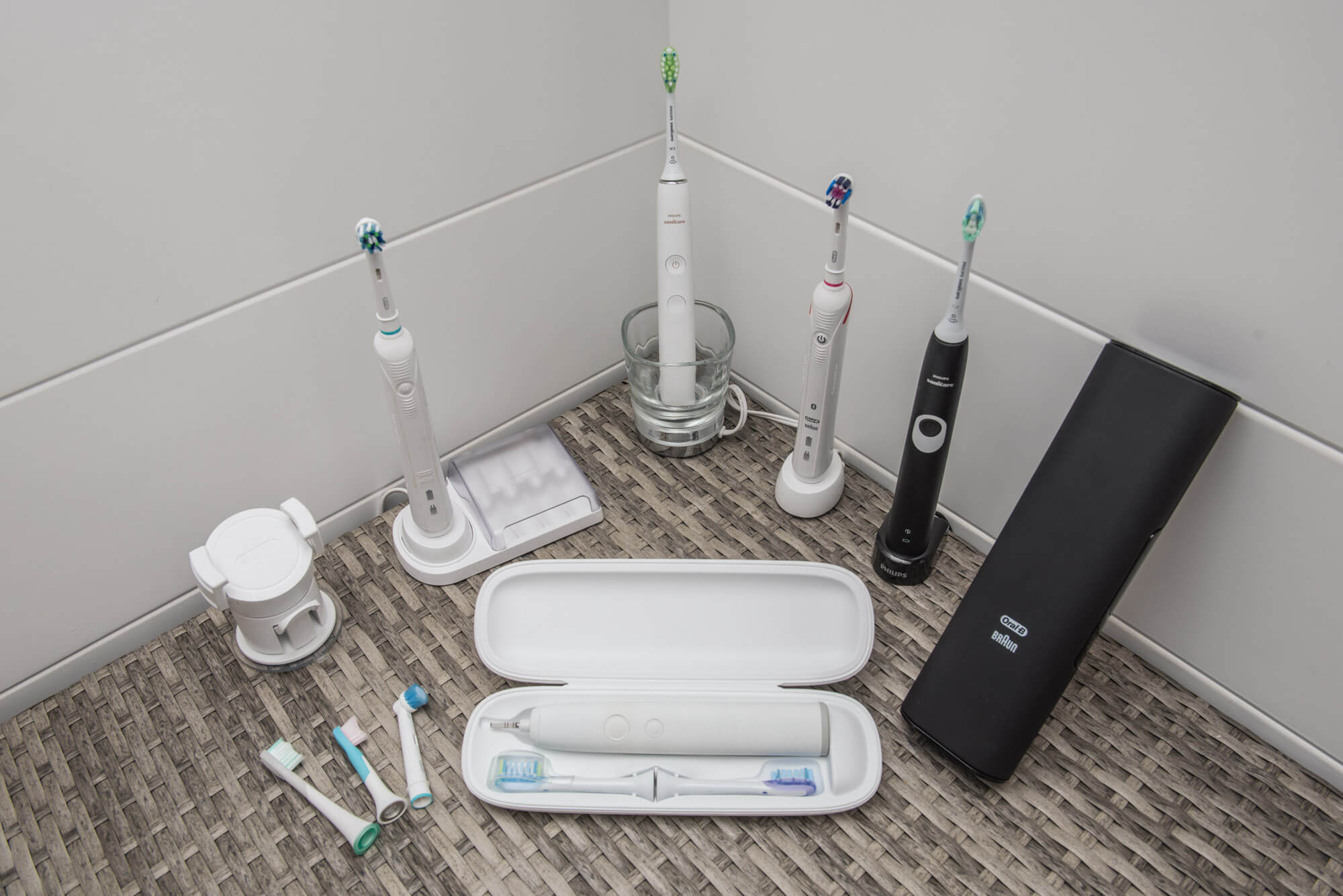
Heads for sensitive gums: Softer bristles are better for nearly everyone. In order to get approval from the American Dental Association, brush heads have to use fairly soft bristles that will help avoid gum problems. We found that most of the heads shipped with electric toothbrushes are fairly soft, but the “sensitive” heads are also typically a little bit smaller, which we found makes them easier to get around back molars and other tricky spots.
Storage for brush heads: In a few cases, the charging stand includes a place to keep spare brush heads. If you’re sharing a brush handle with a partner, or if your dentist advises that you use a specific accessory head in addition to a regular head, this definitely comes in handy.
Is the ADA seal of acceptance an important feature?
We looked at brushes listed as “approved” by the American Dental Association. They don’t list many brands, but that’s partly because it’s an entirely voluntary standard; a manufacturer has to submit their brush, then prove their marketing claims through expensive clinical trials. Electric toothbrushes only started showing up on the list in late 2017.
To get a direct comment on the real meaning of their list, we reached out to the ADA to learn more about the approval process and the difference between an approved and non-approved brush. They directed us to this page that lists the requirements:
“To qualify for the Seal of Acceptance, the manufacturer of a manual toothbrush must provide evidence that:
- All toothbrush components are safe for use in the mouth.
- Bristles are free of sharp or jagged edges and endpoints.
- Handle material demonstrates durability under normal use.
- Bristles won’t fall out due to normal use.
- The toothbrush can be used without supervision by the average adult to provide a significant decrease in mild gum disease and plaque.”
Unlike standards that have easily measured numbers attached to them, like efficiency rating for air conditioners or clean air delivery rate for air purifiers, this is a fairly simple pass or fail.
When we asked the ADA if any toothbrush has ever been submitted that’s bad enough to fail, ADA content specialist Mike Bittern said, “The list of manufacturers that apply for their products to receive the Seal of Acceptance is confidential information the ADA does not share.”
Even that requirement to use clinical trials to show a decrease in gum disease is fairly loosely enforced: Oral-B, for example, submitted all of their brushes in one batch with a confusing array of studies to support them, while Philips only submitted one model (and not even their most expensive model).
It’s safe to assume that the “average adult” can get a significant benefit from using just about any toothbrush, seal or not.
If the ADA were making recommendations for a specific kind of electric brush mechanism, or approving a specific brush attachment, we might be inclined to weigh the ADA seal as a more important benefit. As it is, we didn’t let the lack of a seal stop us from testing or recommending non-ADA alternative brands.
What do I get for more money?
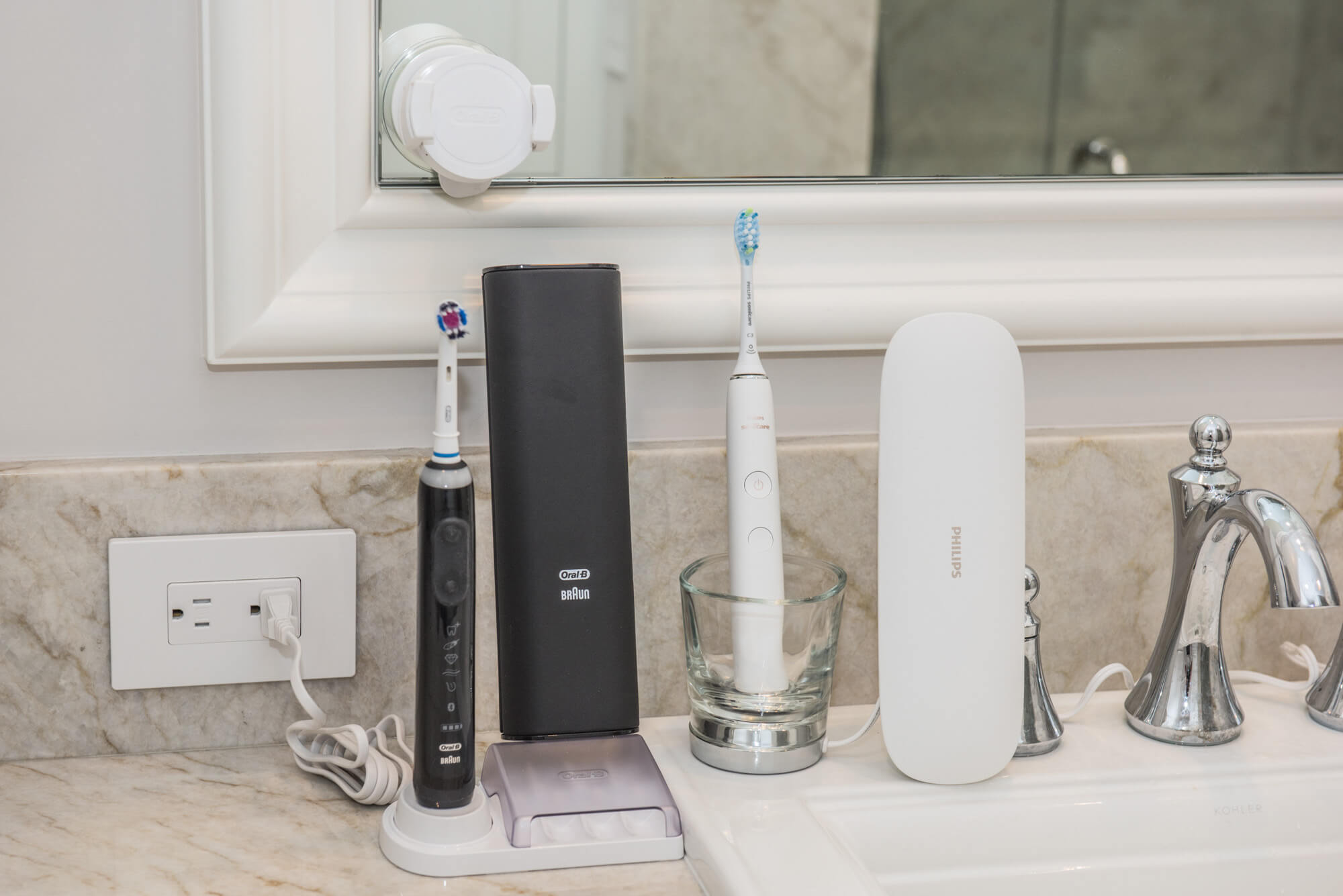
One important question we set out to answer was “what’s the difference between a $20 toothbrush and a $200 toothbrush?”
We were expecting to see more in the way of specific claims and obvious quality differences, but that’s not what we found at all. The distinctions that set top-of-the-line brushes apart from lowly entry-level models are special touches, but most of them don’t translate to any difference in your oral hygiene.
Bluetooth connectivity is one feature that stood out as carrying the biggest premium and also the least pay-off. Maybe the most significant difference you get with Bluetooth is toothbrush updates: There was every month for the Philips – DiamondClean; we can’t decide if that’s good or just annoying. Practically speaking, Bluetooth serves as a way for manufacturers to make sure you only get the high-end features of their system when you spend more money on a Bluetooth-enabled brush.
Position sensors tell you what parts of your mouth you spend the most or least amount of time on. Sensors record in 12 specific zones only (right/front/left in top/bottom inside/outside) but that’s probably as many zones as we want to track anyhow. The position sensor also tells the app if you’re scrubbing back and forth too much instead of letting the motor do the brushing.
Brush head tracking on the Philips brushes uses a tiny RFID chip on each brush head to help the toothbrush know when you’ve replaced worn-out bristles, and even to switch modes automatically if you buy a specific head for something like whitening or gum care. It’s nifty to automatically see all your brush heads in the app, but mode switching is pretty easy with the button and the colored indicator bristles already help you see when the brush is ready to retire.
Fancy storage cases and chargers are probably the most obvious perk of buying a high-end brush. Oral-B gives you a place to put four brush heads on the 3000 and the 8000, and the 8000 also comes with a travel case with a USB charge port and smartphone stand built-in for using your app on the road. Philips gives you a decent travel case with the 5100 and all DiamondClean models, and the trademark drinking glass charging stand is standard for the DiamondClean line, but the travel charger and brush holders are reserved for the super-premium DiamondClean 9750 kit.
Countertop timers and coaching devices used to be included in Oral-B’s high-end brush models, but they’ve been replaced entirely by smartphone apps. If you want a quad-timer display to visualize your brushing progress and pressure feedback without connecting a smartphone or tablet, you can still buy the old Oral-B SmartSeries 7000 for a small discount compared to the new app-only model.
How we tested
To find out how well they perform in real-world conditions, a family of three tested these twelve brushes for four months. They compared plaque removal, battery life, clever (and silly) design features, noise and vibration concerns, storage and charger options, and cost of ownership. They also compared Bluetooth-connected apps for the high-end brushes from Philips and Oral-B.
Evaluating modes and features
| Brush | Pressure Sensor | No. of Modes | Mode Button | Bluetooth |
|---|---|---|---|---|
| Greater Goods - Balance | See below | 4 | Yes | |
| Oral-B - Pro 1000 | Yes | 1 | N/A | |
| Philips - DiamondClean HX9903 | Yes | 4 | Yes | Yes |
| Oral-B - Genius 8000 | Yes | 6 | Yes | Yes |
| Philips - Sonicare Essence HX5611/01 | No | 1 | N/A | |
| Philips - Sonicare 4100 HX6817 | Yes | 1 | N/A | |
| Philips - Sonicare 5100 (684) | Yes | 3 | Yes | |
| Oral-B - Pro 3000 | Yes | 3 | No | Yes |
| Brio - SmartClean | No | 3 | No | |
| Fairywill - CrystalBlack FW-507 | No | 5 | No | |
| Oral-B - Vitality | No | 1 | N/A | |
| Oral-B - 3D White | No | 1 | N/A |
Let’s face it, for most of us adding more modes to a toothbrush increases the confusion more than the value. The sad truth is that while extra control is nice, none of these features are really worth spending a lot of money on.
Here’s our take on the common features that the big brush makers use to distinguish between their different price levels:
Pressure sensor: This is the main feature you pay for in a $40 brush compared to a $25 brush. The pressure sensor will change the brush speed and flash a light to let you know when you’re pressing too hard.
In theory, this is a built-in coaching tool that helps stop you from wasting time or damaging your gums. In practice, we found it pretty easy to figure out how much pressure to use, and the pressure sensors that were calibrated to a lighter touch would always go off when brushing around the back molars.
We were a bit surprised to find out that if you bear down a little bit too much with the Greater Goods – Balance it will basically stop brushing. The manufacturer says that this isn’t intentional, but it works about as well as the pressure sensor on the less expensive Oral-B or Philips models.
Adjustable power levels and specialized modes: More expensive brush handles in the $70 price range can change the speed or strength of their brushing action to deliver more aggressive (or more gentle) scrubbing.
Among brushes from Philips and Oral-B, you get more control when you pay for a more expensive brush. The $200 Philips – DiamondClean Smart has specific customization for the strength of vibration within every mode, and we’ll admit that level of control was appreciated while our mouths were getting used to the sonic tickle.
The biggest distinction among multimode brushes is how you switch settings: A dedicated mode button is simple and sensible, while brushes without the button (like the Oral-B – Pro 3000) force you to cycle through every mode even when you’re just turning the brush on or off.
Among lesser-known manufacturers, four or five modes is standard fare, even for a budget-priced brush. Since the major difference we found is comfort, we tried not to give excessive weight to the presence of these modes. The fact that Greater Goods included a mode switch, though, made it stand out.
Bluetooth and position sensors: This is the feature that you really have to shell out for. On the most expensive brushes, a Bluetooth connection to the app allows the companion app to track where in your mouth you scrub too quickly or with too much pressure.
We were fascinated by the sophistication of this kind of record and a bit baffled about who would really benefit from all that information.
If a detailed record of how much time you spend brushing your inside-upper-left molars compared to your lower incisors is exactly what’s been missing from your life, Philips and Oral-B can both deliver. We liked the Philips app a bit more than Oral-B’s system, but they’re both capable.
Cleaning Performance
| Brush | Rating After 10 Strokes | Rating After 20 Strokes | Total Performance Rating (Out of 6) |
|---|---|---|---|
| Greater Goods - Balance | 3 | 3 | 6 |
| Oral-B - Pro 1000 | 1 | 1 | 2 |
| Philips - DiamondClean | 3 | 3 | 6 |
| Oral-B - Genius 8000 | 2 | 2 | 4 |
| Philips - Sonicare Essence | 2 | 3 | 5 |
| Philips - Sonicare 4100 | 3 | 2 | 5 |
| Philips - Sonicare 5100 | 3 | 2 | 5 |
| Oral-B - Pro 3000 | 1 | 1 | 2 |
| Brio - SmartClean | 2 | 2 | 4 |
| Fairywill - FW-507 | 2 | 2 | 4 |
| Oral B - Vitality | 1 | 2 | 3 |
| Oral B - 3D White | 2 | 2 | 4 |
| Control (Manual Brush) | 2 | 2 | 4 |
We looked for ways to rank daily brushing effectiveness, but after our lead tester tried a few different methods to measure results, we started to realize that these kinds of raw performance tests aren’t really representative of what’s important about a toothbrush.
The most effective method for evaluating brush performance is to use dental disclosing tablets; this is basically bright colored dye that stains plaque and tartar on your teeth so you can see it. You’ve probably been through this routine with your dentist: Brush as normal, chew the tablet, and see what you missed.
The problem with using disclosing tablets to rank brushes is that the tablets demonstrate flaws in the brusher more than the brush. We found that the biggest difference between our test samples wasn’t that some brushes are better, but that our tester’s results got better over time with every brush as he started paying close attention to what he was missing.
We even went so far as to use acrylic model teeth and a piece of textured nylon to test the brushes in more controlled conditions. But the real lesson was a simple one: The best way to get cleaner teeth is to find out what’s missing with your current technique.
We need to be crystal clear on this point: You’re still going to need to practice with an electric toothbrush to get really great results. No brand or type of brush is a magic bullet, and if you’re expecting a brush to restore a receding gumline or whiten your teeth all by itself, you’re going to be disappointed.
As mentioned above, dentists have been repeating the same line to us for years: buy any electric toothbrush (seriously, it doesn’t matter which one) and use it for two minutes twice per day. If you want to maximize plaque removal, gum health or any other specific benefit, the most productive thing you can do is show your dentist how you’re brushing and get feedback on how to improve.
Testing softness
One of the two qualifications for a toothbrush to earn approval from the American Dental Association is that it needs to have soft bristles. The days of wire-stiff toothbrush bristles are over: Brushmakers are using the same nylon filament as before, but with thinner shafts for more flexibility.
There’s a small trade-off here: More flex means less scrubbing and a shorter life before the bristles are worn out, but the reduced risk of receding gums is definitely an outcome we’re happy with.
We tested softness on ripe tomato skins and hard-boiled eggs. None of the toothbrushes damaged the tomato, but the sonic-type toothbrushes quickly started breaking apart the hard-boiled egg. Oral-B’s oscillating scrubbing motion should be more gentle on extra-sensitive gum tissue than the competing sonic-type brushes, but only barely. This also means they’re slightly less efficient at breaking up food between your teeth, but again, only barely.
The bigger concern for sensitive mouths will be ticklishness. If the idea of your teeth resonating in musical tones makes your jaw quiver, Oral-B is definitely the safer bet.
Battery test
After running each brush for a week of testing and battery charging, we topped them all off at a full charge and then ran them until they would no longer brush.
One note on these tests: Oral-B’s brushes use old-fashioned nickel-metal-hydride batteries, while every other brand uses lithium ion. This accounts for a big difference in expected battery capacity, and the results aren’t surprising once you learn that.
The Fairywill and Brio brushes both showed amazing improvements in capacity over the other designs. That said, even the worst performer (the Oral-B – Pro 3000 at 44 minutes) will give you three weeks of brushing, and the no-fuss wireless charging stands all work very well to keep your brush at the ready.
Cost of ownership
| Brush | System Price at Time of Review | Cost of Heads, Per Person, Per Year | Total Cost, Three Years, One User | Total Cost, Three years, Two users |
|---|---|---|---|---|
| Greater Goods - Balance | $19.95 | $19.96 | $79.83 | $139.71 |
| Oral B - Pro 1000 | $39.94 | $13.60 | $80.74 | $121.54 |
| Philips - DiamondClean | $174.00 | $36.00 | $282.00 | $390.00 |
| Oral B - Genius 8000 | $149.99 | $13.60 | $190.79 | $231.59 |
| Philips - Sonicare Essence | $19.95 | $35.92 | $127.71 | $235.47 |
| Philips - Sonicare 4100 | $39.95 | $36.00 | $147.95 | $255.95 |
| Philips - Sonicare 5100 | $69.95 | $36.00 | $177.95 | $285.95 |
| Oral-B - Pro 3000 | $74.79 | $13.60 | $115.59 | $156.39 |
| Brio - SmartClean | $68.00 | $23.96 | $139.88 | $211.76 |
| Fairywill - FW-507 | $27.99 | $10.00 | $57.99 | $87.99 |
| Oral B - Vitality | $24.97 | $13.60 | $65.77 | $106.57 |
| Oral B - 3D White | $5.99 | $10.00 | $40.99 | $81.98 |
Without a clear performance metric to hang a ranking on, and with so many options to choose from, the cost of buying a toothbrush and replacing the heads became a more and more important factor to consider. We calculated the total cost of ownership for each brush over three years to account for the inevitable death of rechargeable batteries.
When you add a second person buying replacement heads, that cost becomes even more important.
The Philips Sonicare heads are very nicely made, but all of the cheaper competitors we tested claim to be using the same Dupont Tynex nylon (which has been the gold standard for toothbrush bristles since it was invented in the 1930s.)
When Oral-B sells their replacements for one quarter the price of a Philips brush package, you start to question the sanity of adding microchips to disposable toothbrush heads. Sonicare is a premium brand for Philips, and they seem intent on milking that for all it’s worth.
We factored the brush head replacement cycle on these brushes at four times per year, but bumped the Greater Goods system up to six times per year, since the bristles they ship with are softer than average and will wear more quickly. If you switch to medium bristles, they should last about as long as any of the other bristles; they’re a better-than-average value either way.
Finding the best electric toothbrush for kids
We intended to test and recommend a specific model for kids three years and up, but it ended up being more tricky than that.
Our tiny tester definitely felt that the sonic brushes were “more tickly” than the oscillating heads from Oral-B, but the noise of those brushes was just as intimidating. Our parent/toddler team wound up using most of the brushes manually, without turning them on.
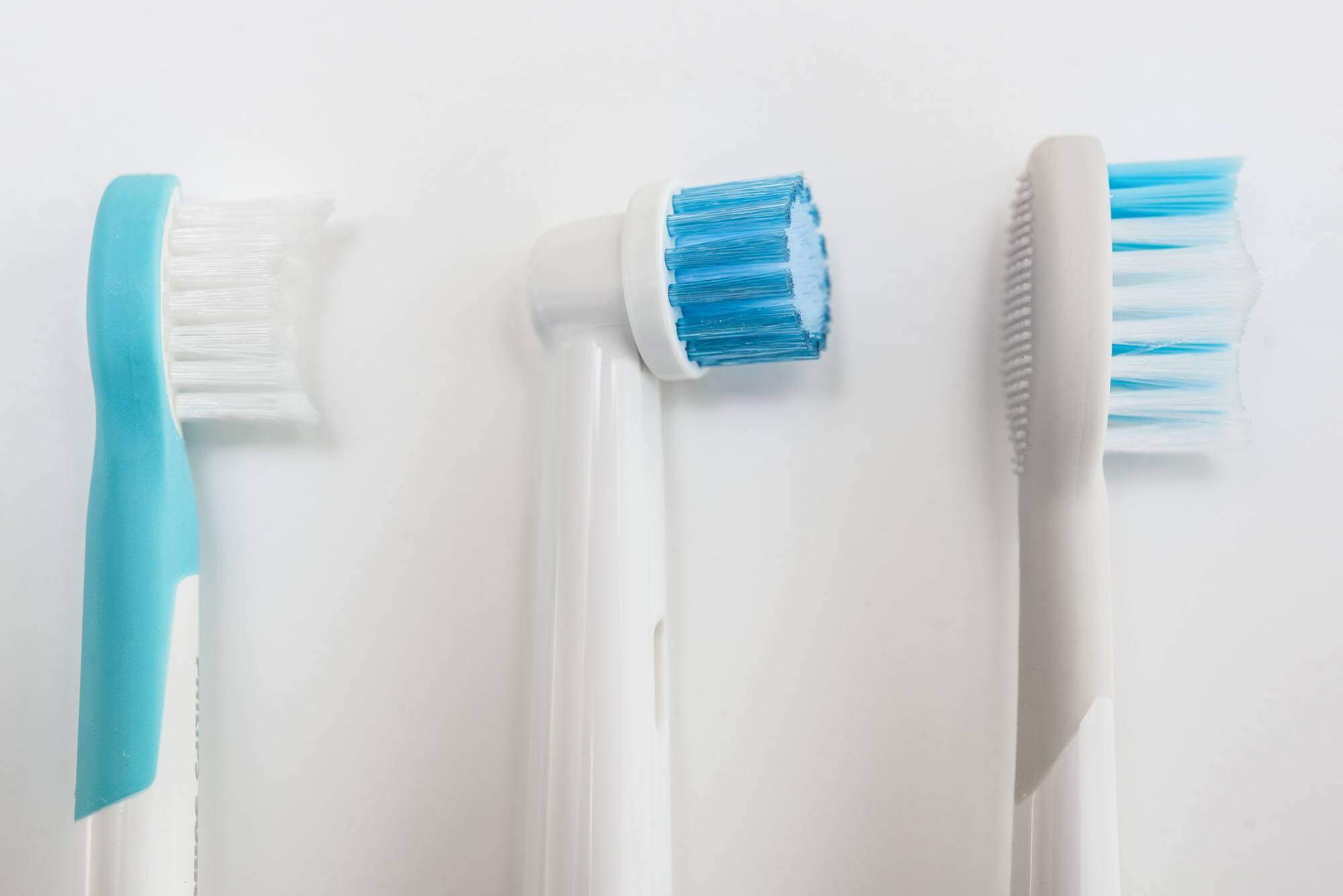
The Philips – Sonicare for kids brush heads are easier to maneuver in a small child’s mouth than the equivalent Oral-B – Sensitive brush head. The Philips head is smaller and narrower than other brushes, and that’s a good thing; Oral-B sticks with their standard size, and it’s still a bit tricky to get behind molars in tiny mouths.
Oral-B does make a few other sizes and shapes for their “Stages” series, but finding and buying them is a mess. (And many are actually bigger than the standard sensitive head.) The electric brush head replacements get mixed in with the manual brushes in store listings, and finding the brush head with the color and character design that matches your kid’s handle is infuriating. Local retailers we checked had a good selection of character choices when purchasing the Oral-B brush handles, but no replacement heads.
Brushing apps for kids
All of the kids toothbrush apps we tested were really just timer apps. They add value in two ways. First, apps make the brushing experience more exciting. Second, they track your routine and reward you for keeping good habits.
Oral-B has the “Disney Magic Timer” app. When brushing, you “scrub away” bubbles from a static image of the characters on your branded toothbrush, which was fairly entertaining for our tester.
Philips, on the other hand, built their Sonicare for Kids app around a virtual pet: “Sparkly” needs its teeth brushed to stay happy, and you get treats and accessories to feed and customize your “pet” after you brush. This is the feature that our test toddler really went for: surprise rewards for brushing.
Sadly, your Sparkly doesn’t get the good stuff (clothes and accessories) without the overpriced Bluetooth-connected kid-specific brush handle. Otherwise, the Sonicare for kids app works quite well with any old toothbrush.
If you’re just looking for a toothbrush with smaller, softer bristles and control over the vibration speed, the Greater Goods – Balance is our pick.
If you’re ready to spend $40 on a Sonicare for Kids brush handle, it does unlock special accessories for your kid’s “Sparkly” pet in the app, but there’s nothing else about that brush to justify the price tag.
Top pick: Greater Goods – Balance
The Greater Goods – Balance would be a competitive entry at $50 or $90, but the fact that it’s a great sonic-type brush selling for less than $30 makes it an easy pick for best value.
After three months of testing, we started to realize that we were never going to find an overall winner that would be perfect for everyone. Some people won’t like the vibration of sonic brushes, though others will definitely appreciate how much quieter they are. Some people will be better off with smaller brush heads, while others will benefit from more efficient brushing with a bigger head. Some people will want to use a variety of modes for things like gum massage and deep cleaning, while others will just be annoyed by the complexity.
Greater Goods has found a good middle ground in just about every category we considered, and the bonus perks aren’t cumbersome or gimmicky.
The standout feature for Greater Goods at a sub-$30 price point is the quad pacer. The brush makes a cheerful little buzzing pulse as a reminder to move to the next part of your mouth every thirty seconds. No app required! The Balance is the only budget-priced brush with a quad pacer, and this feature is one of the most effective ways to improve your brushing routine.
The only feature that’s really missing from the Greater Goods is a pause function if you stop the brush to spit out excess toothpaste; when you start it up again, the timer resets to a full 2 minutes.
The charger is a compact wireless-charging stand, just like most brushes we tested. Unique at this price point is a battery status light that turns red when you’ve got about six brushing sessions left. It also indicates when it’s charging and when it’s full; the competitively-priced Oral-B – Vitality doesn’t have any battery lights.
The battery is big enough for almost a month of brushing between charges, but the toothbrush is still cheap enough that you won’t be as frustrated when you need to replace it in two or three years when the battery stops working. (And it will; They all will.)
The Greater Goods brushes are on the smaller side, which is better in our experience than having a head that’s too big. The bristles are soft, maybe even softer than the bristles Philips is using. Greater Goods also sells medium and firm bristles if that’s your preference. Our dentists have always encouraged us to go for softer bristles when we have a choice, but the optional firm-bristle replacements will last longer.
Confirm with your dentist about what’s best for you, but softer bristles make this the best electric toothbrush for receding gums.
There’s a textured-silicone tongue scraper on the back of the brush head; it’s not an especially aggressive scraper, but not bad for a back-of-the-toothbrush design.
The four different modes Greater Goods offers are distinct enough to be meaningful, but as with the other brushes we’re skeptical that the faster vibrations are really any better at whitening. If the vibration is too much at first, it’s nice to have the option to use the “sensitive” mode. The feature that really stands out is mode switching with a dedicated button; usually that only shows up on much more expensive brushes.
The plaque-cleaning performance of this brush in our daily brushing and simulation tests is exactly what we’d expect from a sonic toothbrush: slightly better than the Oral-B oscillating system at clearing away sticky material.
So, why not some other cheap brush?
Greater Goods has a few unique features: a mode button makes turning the brush on and off much less annoying, and the brush heads are a little bit nicer and have a tongue-cleaner built in. This makes it the best cheap electric toothbrush we found.
Greater Goods isn’t the only company selling this particular brush design. Just looking at Amazon, you’ll see that brushes from Mornwell and Aquasonic appear to be coming off the same production line with a different colorway and packaged with different accessories.
We spoke with Patrick Kohm, operations manager at Greater Goods, and he didn’t divulge anything about their manufacturing partners on the record, but a timeline is pretty revealing. Greater Goods launched their new Balance toothbrush design in early 2017. Shortly thereafter, Risun Tech founded the Mornwell brand to sell oral care products direct from their manufacturing plant.
We like the design either way, but Greater Goods has a real telephone support team that’s located stateside.
This brush won’t automatically make you better at cleaning hard-to-reach spots than any other brush, but we like that it doesn’t trip you up with a clunky interface or confusing options. This is a great brush at a great price, and in our interactions with Greater Goods customer service, they seem like a company on track to do even more great things in the future.
Key takeaways:
- The sonic-type Greater Goods – Balance has the timer and pace reminder features you need to reinforce good brushing habits.
- Adjustable power levels and soft bristles are a win for gum health and sensitive teeth.
- A dedicated mode button makes the optional modes less annoying to use than other affordable models.
- If you pause brushing, the timer will start over.
- Greater Goods is a US company providing real support, but they’re competing for the lowest price point.
For sensitive teeth: Oral-B – Pro 1000
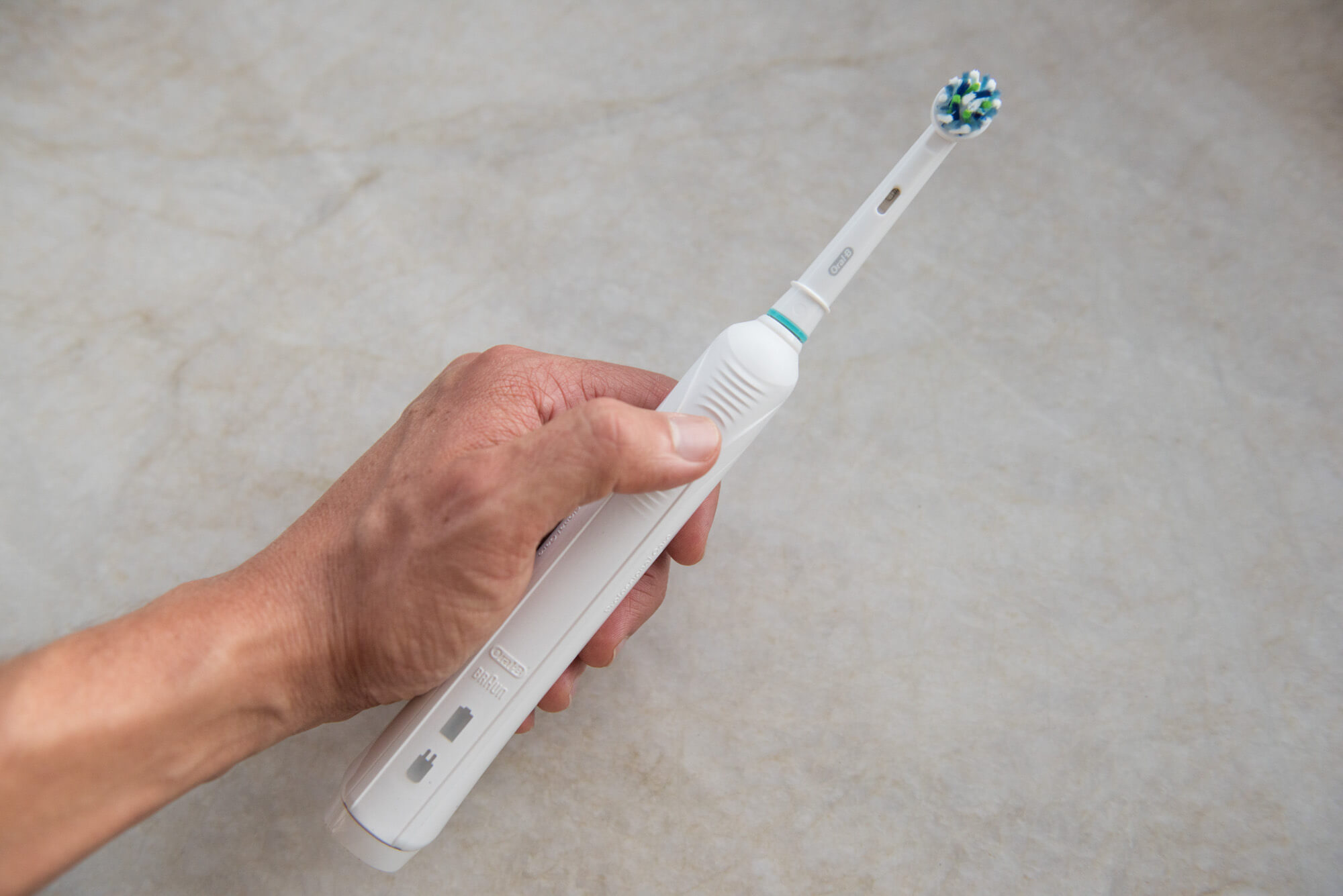
If you don’t want a sonic-type toothbrush, or if you need a specialized brush head for a unique problem you’re facing, the Oral-B – Pro 1000 is a great choice. Oral-B offers the largest selection of brush head types, and the Pro 1000 is the best value in their lineup.
Compared to the smooth, quiet bumblebee hum of other electric toothbrushes, the Oral-B design sounds like a cross between a power drill and a clattering dishtray. The oscillating brush snaps back-and-forth in much larger semi-circular movements than the sonic-power brushes do, and that’s the trade-off. Since the bristles move more slowly over a larger distance, they’re still effective at removing plaque without buzzing your entire jaw from the inside-out.
Oral-B’s other big win is the sheer variety of tools they offer: Iif you need an interdental tip to clean a tricky gap, plus a polishing cup to make the most of your whitening toothpaste, plus a soft brush that you can give your kids, Oral-B has you covered.
Oral-B’s replacement brushes are also available at a much lower cost than most of the competition when you buy in a 10-pack. By comparison, Greater Goods is competitive even in a three-pack, which is one reason they won our best value pick, but we didn’t find the Philips Sonicare replacement heads any cheaper than $8.33 each (and you need to buy them at Costco to get that price.)
While you’ll probably regret skipping the features and buying a cheaper Oral-B model, we also consider the Pro 1000 the most expensive toothbrush most people should buy. The Pro 3000 just adds two extra brush modes, and you’ll need to cycle through all the modes every time you use the brush (whether you use them or not). The Genius only really adds a position sensor for tracking your brushing habits.
Compared to other Oral-B brushes

| Oral-B Brush | Pressure Sensor | Quad Pacer | No. of Modes | Bluetooth | Other Features |
|---|---|---|---|---|---|
| Pro Health Jr. (Not Tested) | No | No | 1 | Kids' app only | Unlock characters in kids' app |
| 3D White | No | No | 1 | No | Uses AA battery |
| Vitality | No | No | 1 | No | |
| Pro 1000 | Yes | Yes | 1 | No | |
| Pro 3000 | Yes | Yes | 3 | Yes | Switch modes with power button |
| Pro 5000 (Not Tested) | Yes | Yes | 5 | Yes | Dedicated mode button |
| Genius 8000 | Yes | Yes | 5 | Yes | Position detection (uses phone camera) |
Oral-B has stuck to their gun with the oscillating toothbrush heads that made them famous. If the idea of a buzzing sonic-type toothbrush in your mouth is a turn-off, we think this is easily the best buy in the oscillating brush category. The heads are about half the price of the competing Goby subscription system, and you can buy them nearly anywhere.
Key takeaways:
- The Oral-B – Pro 1000 doesn’t tickle your mouth like a sonic-type brush.
- Oral-B makes brush heads with every feature you can imagine, from interdental tips to polishing cups.
- This model has all the essential features at a reasonable price.
- Oral-B’s oscillating design works, but doesn’t seem to clean quite as well as the sonic-type brushes.
- The 44 minutes of battery life is adequate, but not competitive.
Best premium electric: Philips – DiamondClean

The Philips – DiamondClean Smart Series is the flagship of the Sonicare fleet, and the model 9300 (also called HX9903 depending where you look) gets you the premium features that set this sonic toothbrush system apart.
Bluetooth is the backbone feature for every premium toothbrush currently on the market. Philips tracks every sensor on this brush and records when and how you’re using it with the smart-device app.
If you don’t want to use an app every time you brush, there’s really not much reason to buy a brush that costs more than $40. If you do want to use an app, we think the Sonicare app is the best, and this very nice toothbrush will make the most of it.
Another unique feature of the Sonicare system is the replacement heads: The 3-series heads all have unique ID tags that let the brush and the app know which mode they’re designed for. They also track how long you’ve been using a specific head, so you can get automatic reminders to replace them even if you’re using multiple head types or sharing the brush handle with your family.
Automatic mode switching is a great feature, because there are a lot of modes available: Clean, White+, Deep Clean+ and Gum Health all correspond to a specific Philips brush head, but you can manually set any mode you like. You can also choose from three power levels within each mode.
Adjustable power levels are the most compelling feature of this brush, because it offsets the biggest liability of the Philips Sonicare technology: the tickling sensation you get when the brush is vibrating against your teeth, gums or cheek 260 times per second.
We interviewed friends who are long-time users of the Sonicare system, and they all claimed they didn’t notice the vibration anymore. If you’re worried about how your teeth will respond in the beginning, adjustable power levels will help you ease into it.
It is really better for brushing?
We mostly tested this brush with the standard clean mode, and it tied for first place in our peanut-butter-cleaning test. We’re not going to say that it will remove more plaque from your teeth than another brush would; that depends on your technique. But this is the most power and versatility you can get.
The battery life for the Philips – DiamondClean was actually 30 percent lower than the other Philips models. This could be because the brush never turns off its Bluetooth transmitter. Still, it’ll brush your teeth 57 times without recharging — that’s almost double the battery life of the Oral-B – Genius 8000.
Philips’ Sonicare system is quieter in every case than the Oral-B system, but the premium DiamondClean is just a little bit quieter on the standard clean mode than the other Philips brushes. It’s not a dramatic difference, but the brushes seem to have fewer and fewer parts buzzing around inside as you climb the price ladder.
Compared to other Philips brushes
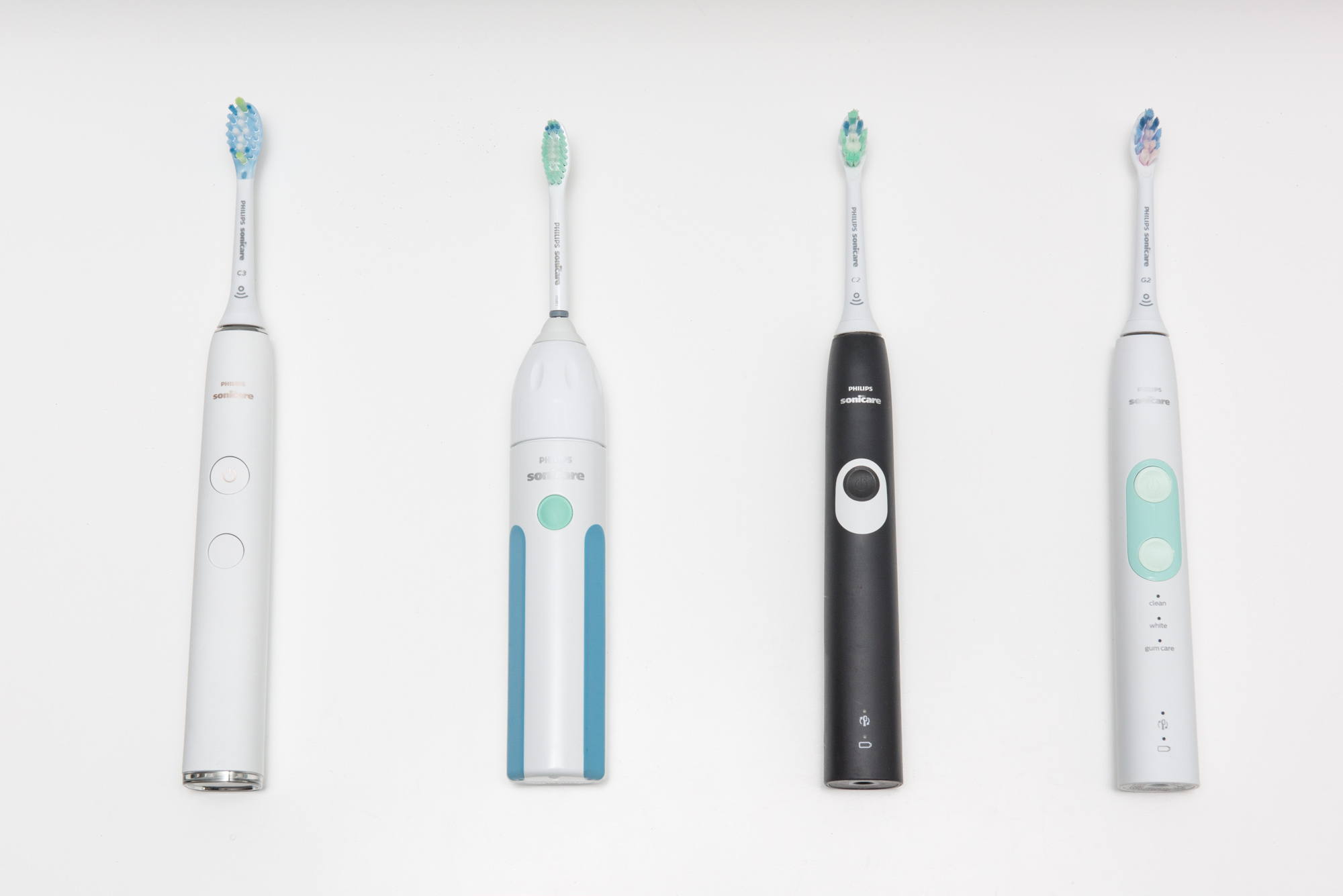
| Philips Sonicare Brush | Quad Pacer | Power Settings | Bluetooth | Brushsync Modes | Other Features |
|---|---|---|---|---|---|
| For Kids HX6321 | Yes | 2 | Kids App Only | No | Unlock App Extras |
| Essence HX5611 | No | 1 | No | No | Old-Style Heads |
| Essence+ HX3211 | No | 1 | No | No | New Sonicare Heads |
| 4100 HX6817 | Yes | 1 | No | No | |
| 5100 HX6850 | Yes | 1 | No | No | Three Manual Modes |
| 6100 HX6877 | Yes | 3 | No | Yes | |
| DiamondClean 9300 | Yes | 3 | Yes | Yes | Position Sensor (Built-In) |
Premium design and accessories
The premium feel of this brush is for all intents and purposes a design feature. The body is a little bit slimmer and sleeker than the lower-priced brushes, and the available color schemes cater to people who appreciate fine designer goods.
A Premium Upgrade: Philips - DiamondClean
Philips lets the premium look and accessories carry this brush to a stratospheric price, but if you want to make the most of a Bluetooth-connected app it's definitely the brush with the most features. The price tag and cost of replacement heads definitely took this brush out of the running for overall winner, though.
The DiamondClean model 9300 we tested comes with a pebble-grain-wrapped travel case that holds the handle and two brush heads. If you pay another $60 for the model 9500, you also get USB-port charging in your travel case so you don’t have to take your stand on the road. These cases aren’t explicitly designed to prop up a smartphone the way Oral-B’s case is, but the slot for the handle works fairly well.
The wireless charging stand (a standard feature in all electric brushes nowadays) also comes with a nice, heavy water glass that fits securely on top. This has basically become a signature feature of the DiamondClean brushes, and it’s definitely a unique touch. There’s also a clear plastic adapter for the charging stand if you don’t want to use the glass.
If you jump to the even more expensive model 9750, you also get an exclusive glass countertop stand for four brush heads. The price is within spitting distance of $300, so it only really makes sense if you’re really, really proud of those $12 brush heads.
Should you really buy this?

If you’re mostly looking for a sleek brush with top-tier cleaning performance, the Greater Goods brush gets you the same sonic cleaning performance the DiamondClean does. We like the Greater Goods brush heads, but here’s a twist: The various Philips Sonicare brush heads mount securely and work just as well on the Greater Goods handle. The arbor they mount on isn’t identical, but it’s got all the same key dimensions for the retaining clip to work.
If you love glass and copper-tone accents, Philips is the way to go. (We’re just a bit saddened that there aren’t brush heads to match the lunar blue handle. Blue and black? Seriously?) As with Philips’ high-end shaver, it’s beautiful product that doesn’t make sense for most people to buy.
Key takeaways:
- The Philips – DiamondClean model 9300 is the Bluetooth-connected sonic brush that looks, feels and performs like a luxury product.
- Philips’ smart app works with a position sensor, brush sensor and head sensor to do something special with that connected advantage.
- This brand tied for best cleaning performance in the lab, but that might not matter at all. (And it tickles.)
- You could even drink your expensive scotch out of the swanky charging stand glass. That’s worth the price, right?
The other finalists we tested

Oral-B – Genius 8000
The Oral-B – Genius 8000 is a good toothbrush. All the features you could ask for are here, and more. The travel case even has a built-in USB charge port for your phone!
The great ideas often weren’t followed through, though. For example, the charger doesn’t put out enough amperage to charge a modern phone or tablet: iPads and phones sometimes started charging, and sometimes didn’t. “Near-miss” pretty effectively sums up many features on this high-end brush.
We were sorely tempted to give the Genius 8000 top spot in the premium category. The features are competitive: easy and programmable mode switching, a great selection of brush heads, and position and pressure tracking to make sure you’re not over- or under-brushing certain areas.
The Oral-B’s price is a bit better than the Philips system, too, both for the brush handle and for the replacement heads. The Oral-B is loud and clunky, though, compared to the soft hum of the Philips Sonicare technology. The app is good enough, but not quite as easy to navigate or set up as the Philips app.
The built-in charger in the case is a cool feature that almost makes this the best electric toothbrush for travel, but you’ll also be more likely to need that charger. Oral-B’s 64 minutes of battery life are pathetic compared to the 114 minutes we got from the Philips – DiamondClean. Thankfully, this brush has a three-segment display so you can actually see the battery level.
If you’re really compelled by the value of the specialty brush heads Oral-B offers, the Pro – 1000 gets you into that system at a much more reasonable price point and has all the essential features.
Philips – Sonicare Essence
The Philips – Sonicare Essence is the cheapest way into the Sonicare lineup, and that makes it a brush worth checking out, but at the end of the day there’s not much that makes this a good value.
The Essence gets the same good cleaning results that the other Sonicare brushes do. The DiamondClean was a little bit better in a lab test, but we think you’d be hard pressed to tell the difference between the Essence and the other brushes if they’re all on the basic cleaning mode.
What separates this brush from the rest of the lineup is the heads it uses. This is an old system that uses a massive threaded collar to hold the tip and its magnetically coupled drive shaft in place. It’s much more bulky and complex than the main Philips system, and still expensive at $35 for a year’s replacements, but that’s compared to $60 for the premium heads.
For that savings, you sacrifice every feature. There’s no quadrant-pacing timer, much less a pressure sensor or variable power levels.
Philips has already released a replacement for this model, the Essence+. The Plus model takes the same brush head as the rest of the Sonicare brushes rather than the bulky old screw-on heads, but just like the Essence it’s missing all the other features.
Sadly, the Essence+ is often selling for almost the same price as the much better 4100 model. If you’re really in love with the Philips brand but you want a bare-bones brush, this older Essence model is typically a much better value.
Philips – Sonicare 4100 and 5100
The Philips – Sonicare series is comprised of dozens of models and combo packs. We tested both the Four Series model 4100 and Five Series model 5100 because they represent the two clear feature changes: The 4100 adds a quad pacer and pressure sensor to the more basic models, and the 5100 adds a “gum care” mode and manual mode switching.
In both cases, we were underwhelmed by these features, especially when compared to the Greater Good – Balance. If the pressure sensor and mode switch were only adding a $20 premium to the price then these brushes might be worth seeking out; after our tests, though, we’re not convinced the pressure sensor really helps, and even after paying three times the price of the entry-level brush you’re going to keep on shelling out more for the $8-$12 brush heads every two or three months.
The “smart” features (like the ID-chipped brush heads) make some sense when you’ve got a Bluetooth-connected app tracking every datum of your brushing life, but those perks are missing on these brush handles.
The batteries are better than average, at 154 minutes for the 5100 and 180 minutes for the 4100, but that in no way justifies the sticker price.
Oral-B Pro 3000
The Oral-B Pro 3000 is in an awkward place in Oral-B’s lineup.
Like the midrange Philips, the features here are hard to justify: A gum care and sensitive mode are both great ideas, but it’s hard to say exactly who will need them, and for how long.
The Bluetooth on this brush is not a well-developed feature, either. It lets you start and pause the smartphone app’s timer in perfect sync with the built-in timer on the brush, but without a position sensor you don’t really get anything else from the app that you wouldn’t also get with a manual brush.
The main reason to buy this brush is if you love the Oral-B oscillating brush heads and want to program a gum massage into your weekly brushing routine. Bluetooth will let the app control that on the schedule that you or a dentist creates; it really is only automating a simple button press, though.
The other feature that comes with this brush, but not the 1000, is a countertop case that holds spare brush heads for your family or special-purpose brush heads. You can buy the same official stand for about $15, or a very similar imitation for about $10.
Forty-two minutes of battery is sufficient, but shameful in a $75 toothbrush. On the whole, the lower cleaning power compared to sonic toothbrushes and the louder motor of the oscillating design makes this a really tough model to recommend.
If the lack of a dedicated mode switch is the only thing you think is missing, you can get that (and some extra modes) for about $15 more in the Oral-B – Pro 5000. After spending a few months with a range of Oral-B models, we’re pretty sure most people will be fully satisfied with the features of the Pro 1000 at half the price.
Brio – SmartClean
The Brio – SmartClean seems like a brush that was built to order around a feature set, rather than being carefully designed and improved after testing.
The SmartClean checks most of the essential feature boxes, except a pressure sensor and a mode switch. It has three modes: normal, soft and massage. These are sensible to include, but without a mode button you’re cycling through all of them every time you start and stop the brush. The white plastic body is hard and shiny where every other brush has a grippy texture.
If this brush were $30 rather than the consistent $68 it sold for when we tested, it would be a competitor for the top pick. At this price, it’s up against the Sonicare 5100. Brio gives you double the battery life and cheaper brush replacements, plus a brush holder on the charger rather than the travel case that comes with the 5100. It’s also a little bit quieter than the midrange Philips models. It doesn’t seem to clean as well, though, and there’s no pressure sensor.
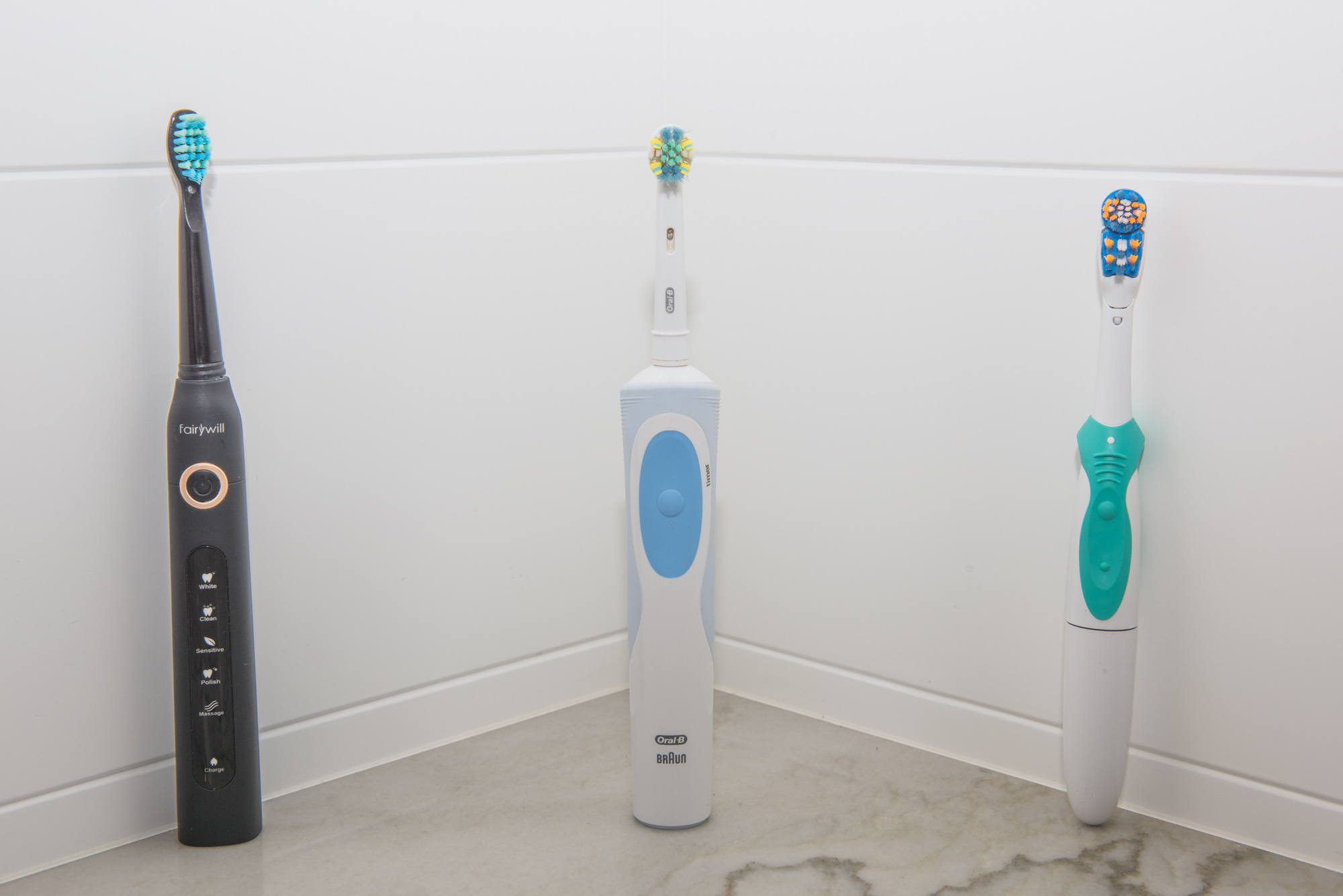
Fairywill – FW-507
The Fairywill – FW-507 feels and looks lower-grade than the other brushes we tried. It’s a popular model on Amazon that seems to share a production line with a number of other brands.
The USB-compatible charge cable is an interesting feature that may come in handy once in a while, but wireless toothbrush stands make far more sense unless you’re constantly travelling.
This isn’t a bad toothbrush, really, but the lack of a mode switch makes the five modes more annoying than they’re worth. Fairywill squeezed the longest run time out of this big rechargeable battery, but a convenient charging stand is a far more important feature for most people.
The Fairywill replacements were the only brush heads we didn’t like. They’re not bad, per se; the bristles appear to be the same soft Nylon used by the rest of the industry, and the shape and size are about right. The way they attach to the handle is a big, hollow mounting shaft with a twist-lock retention mechanism. Again, not awful, just not as simple or easy to clean as other systems.
Oral-B – Vitality
Oral-B’s Vitality model is an entry-level electric toothbrush that should be attractive for offering access to Oral-B’s great brush heads for a low up-front cost. But, when compared to other budget brushes, it’s a bit disappointing.
What’s missing? Nearly everything. There’s not even a charge light to let you know if your charger is plugged in. The lack of a pacing timer is not uncommon for the entry-level model in a big brush maker’s line, but when Greater Goods is offering that feature at the $25 price point, this brush is hard to recommend.
The Vitality has a larger-than-usual battery for Oral-B’s line. It actually runs for 17 days worth of brushing, about a day longer than Oral-B’s flagship brush. This is still 12 days short of the average we found among other brands. It’s also a quieter brush than some other Oral-B models, but on the whole we think the Pro 1000 is a worthwhile upgrade if you want the Oral-B heads.
Oral-B – 3D White
The Oral-B – 3D White is a strange duck. Oral-B clearly recognizes that their brand is strong enough to sell cheap AA-battery-powered toothbrushes.
The 3D White’s cleaning performance in our peanut butter test was pretty good, partly because the head is so much bigger than the other Oral-B heads. That said, it’s actually a bit less efficient at brushing in most actual mouths, since it can be tricky to maneuver that big head.
Battery life is kind of amazing: 305 minutes of constant run time on the included AA alkaline.
That said, this brush fails to meet the basic qualifications that advance most electric toothbrushes ahead of stone-age manual-power brushes. There’s no timer at all, let alone a quad pacer. If we were picking a tool to clean grout lines, this would be a contender for best value of the bunch. As a toothbrush, it’s just a gimmicky waste of time.
The bottom line
The best brush is one you’ll actually enjoy using for two minutes, twice every day. Anything more or less than that is probably not going to make a big difference for your teeth and gums, but it’s a very good idea to schedule a checkup with your dentist so you can talk about technique.
Our favorite brush, then, has all the essential features to make that happen. The Greater Goods – Balance has a two-minute timer with 30-second pacing reminders that help you get every tooth, while the soft bristles and adjustable power modes mean it’ll let you ease into a new routine. (You can change to harder bristles, too, if you want stronger scrubbing and longer bristle life.) It does all this for less than half the cost of the competition.
The Balance doesn’t have Bluetooth. But if you really want to record your brushing habits, the data-collecting features of apps we tested work manually with any toothbrush.
If you really prefer moving bristles to buzzing sonic toothbrushes, the Oral-B – Pro 1000 still has a quad pacer and pressure sensor, plus it gives you access to affordable specialty brushes. It’s double the cost of our top pick and it’s pretty loud, but for sensitive mouths this is a less intimidating option.
If you’re really sold on the idea of a Bluetooth-connected app that will track how long you brush each part of your mouth and let you schedule a customized routine of automatic gum massage, the Philips – DiamondClean is a premium brush that does look and feel like a luxury item.
Top pick: Greater Goods - Balance
For a very low price, this brush has all the features of a top-tier model from a bigger name. The bristles are soft, the mode switch is convenient and you get great sonic cleaning performance. This is a good design that meets real needs without running up the cost on features you'll ignore.
More Reviews
The Best Alkaline Water Filter Pitchers
Brita - Longlast
Bauerfeind
Lululemon - Energy
Feetures - Elite Max Cushion
Patagonia - Strider Pro
ZFOsports
SPRI - High Density Roller
No Cry Cordless
Pado - PureWave - CM-07
Dyson Airwrap Complete Review: Is It Worth The Cost?
Dyson - Airwrap Complete
The 7 Best Hair Straighteners for Thick Hair
BaBylissPro - Nano Titanium
Shark Genius - S5003D


